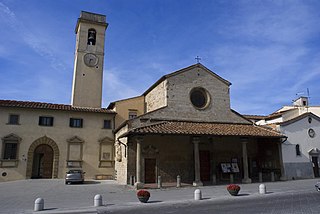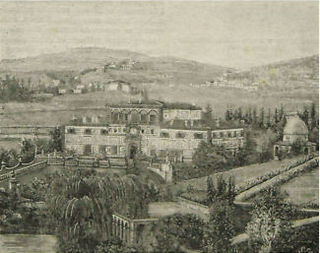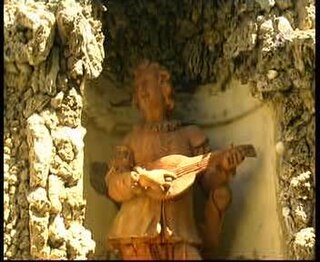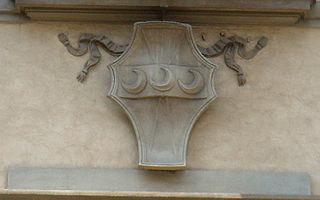
Settignano is a frazione on a hillside northeast of Florence, Italy, with views that have attracted American expatriates for generations. The little borgo of Settignano carries a familiar name for having produced three sculptors of the Florentine Renaissance, Desiderio da Settignano and the Gamberini brothers, better known as Bernardo Rossellino and Antonio Rossellino. The young Michelangelo lived with a sculptor and his wife in Settignano—in a farmhouse that is now the "Villa Michelangelo"— where his father owned a marble quarry. In 1511 another sculptor was born there, Bartolomeo Ammannati. The marble quarries of Settignano produced this series of sculptors.

Ferdinando Fuga was an Italian architect who was born in Florence, and is known for his work in Rome and Naples. Much of his early work was in Rome, notably, the Palazzo della Consulta (1732–7) at the Quirinal, the Palazzo Corsini (1736–54), the façade of the Santa Maria Maggiore (1741–3), and the Church of Sant'Apollinare (1742–8). He later moved to Naples and notably designed the Albergo de'Poveri (1751–81), the façade of the Church of the Gerolamini, and that of the Palazzo Giordano.

Sesto Fiorentino, known locally as just Sesto, is a municipality (comune) in the Metropolitan City of Florence, Tuscany, central Italy.

The Palazzo Corsini is a prominent late-baroque palace in Rome, erected for the Corsini family between 1730–1740 as an elaboration of the prior building on the site, a 15th-century villa of the Riario family, based on designs of Ferdinando Fuga. It is located in the Trastevere section of the city, and stands beside the Villa Farnesina. During 1659–1689, the former Riario palace had hosted the eccentric Christina, Queen of Sweden, who abdicated, converted, and moved to Rome. Under her patronage, this was the site for the first meetings of the Roman Accademia dell'Arcadia.

The Villa di Pratolino was a Renaissance patrician villa in Vaglia, Tuscany, Italy. It was mostly demolished in 1820. Its remains are now part of the Villa Demidoff, 12 km north of Florence, reached from the main road to Bologna.

The Villa Marlia or Villa Reale di Marlia — a late-renaissance palazzo or villa, and its estate's property that includes renowned gardens and adjacent villas and follies within the compound. It is located in Capannori, in the Province of Lucca, west of Florence, in the northern Tuscany region of Italy.

The Medici villas are a series of rural building complexes in Tuscany which were owned by members of the Medici family between the 15th century and the 17th century. The villas served several functions: they were the country palaces of the Medici, scattered over the territory that they ruled, demonstrating their power and wealth. They were also recreational resorts for the leisure and pleasure of their owners; and, more prosaically, they were the centre of agricultural activities on the surrounding estates. In 2013, the Medici villas were added to UNESCO's World Heritage list.

Giardino dell'Iris is a botanical garden specializing in the cultivation of iris flowers, symbol of Florence since 1251. It is located on the corner of Viale dei Colli and Piazzale Michelangelo in Florence, Italy, and open daily without charge from May 2–20 every year.

Villa Palmieri is a patrician villa in the Fiesole, central Italy, that overlooks Florence. The villa's gardens on slopes below the piazza S. Domenico of Fiesole are credited with being the paradisal setting for the frame story of Boccaccio's Decameron.

Villa Gamberaia is a seventeenth-century villa near Settignano, outside Florence, Tuscany, Italy.

Villa Rusciano is a historic villa in the neighbourhood of Florence, central Italy, which includes work by Brunelleschi.

The Villa Salviatino, Maiano, in the frazione of Maiano on the steep slope south of Fiesole, is a Tuscan villa overlooking Florence.
The Villa di Murlo is a rural palace or villa located in the hills surrounding San Casciano in Val di Pesa, on the old road between Florence and Siena that follows the Pesa River.

Marsiliana, known also as Marsiliana d'Albegna, is a village in Tuscany, central Italy, administratively a frazione of the comune of Manciano, province of Grosseto. At the time of the 2001 census its population amounted to 246.

The Boboli obelisk, previously called the Obelisco Mediceo, is an ancient Egyptian granite obelisk, which was moved in the 18th century from Rome to Florence, where it was erected in the Boboli Gardens.

The Palazzo Corsini is a monumental palace located on Via del Parione #11, with a facade towards the Arno River, in Florence, region of Tuscany, Italy.

Villa La Magia is a Medici villa in the comune of Quarrata, in the province of Pistoia, to the west of Florence, in Tuscany in central Italy. It was built by the Panciatichi family in the fourteenth century, and was bought by Francesco I de' Medici in 1583 or 1584. It has been owned by the comune of Quarrata since 2000, and since 2013 has been one of the fourteen sites which together make up a UNESCO World Heritage Site, the Medici Villas and Gardens in Tuscany.

The Church of San Gaggio is Roman Catholic church located on via Senese in Florence, Italy. It was once associated with a large convent.

The Episcopal Palace is a building located in Piazza Mino of Fiesole, Italy. Built in the 11th century, it serves as the residence of the Bishop of Fiesole.



























